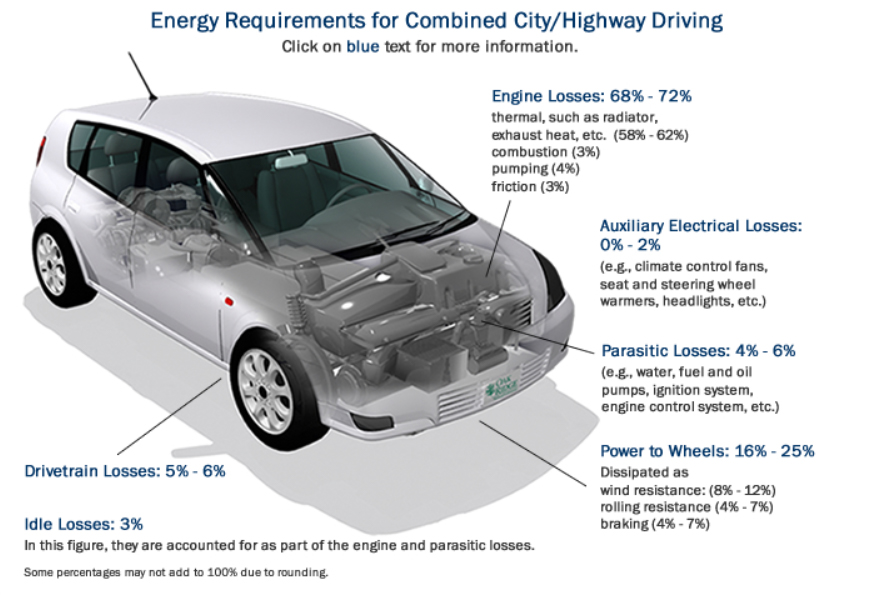An electric vehicle (EV) is a vehicle that runs on electricity. There are three main types of vehicle commonly called "electric", and it's worth knowing the difference:
- Battery electric vehicles (BEVs) run only on electricity. With a BEV, you charge the car's battery with electricity. That battery then powers the electric motor, which propels the car forward. Since the car itself is not burning a fuel to generate movement, there are no tail-pipe emissions. Instead, the carbon footprint of a BEV depends on how the electricity that runs it is produced. Some common BEVs in our program are the Chevrolet Bolt, Nissan LEAF, and Hyundai Kona EV.
- Plug-in hybrids (PHEVs) combine a battery-powered electric motor with an internal combustion engine. You charge your vehicle with electricity and use it much like an all-electric vehicle. However, if and when you run out of charge, the internal combustion engine serves as a back-up. While running only on electricity, a PHEV's carbon footprint again depends on the fuel mix that generated the electricity. As soon as the internal combustion engine switches on, the engine's tail-pipe emissions add to the vehicle's carbon footprint. Some common PHEVs in our program are the Toyota Prius Prime, Mitsubishi Outlander, and Honda Clarity.
- Hybrid electric vehicles (HEVs) also combine an internal combustion engine and an electric propulsion system. However, HEVs are “charged” with gasoline; you cannot plug them in to charge them with electricity, so they are not strictly speaking “EVs”. However, HEVs are more efficient than traditional internal combustion engines because they take advantage of technologies such as regenerative braking. The best known HEV is the Toyota Prius.
When we talk about “EVs”, we’re talking about battery-electric vehicles (BEVs) and plug-in hybrids (PHEVs). The Drive Green program does not include HEVs.
EVs contrast with conventional vehicles, which run on an internal combustion engine: you add a fuel (gasoline, diesel fuel, or ethanol), it ignites and releases energy that is translated into motion. In the process, however, the vehicle releases carbon dioxide, one of the greenhouse gases contributing to climate change.
Want to read more about electric vehicles? In addition to our Drive Green website pages, we write regularly about clean transportation on our blog. Check out our electric vehicle posts here!
EVs are more efficient than gasoline-powered cars
EVs are better for the environment than gas-powered cars, not just because gas-powered cars rely on fossil fuels, but because EVs are more efficient.
Efficiency measures how much of the energy in fuel is converted into kinetic energy to get the tires rolling. It is impossible for any machine to be 100% efficient because some energy is always lost to heat, friction, and wind resistance. But in general, the higher the efficiency, the less energy needed to power a car. In other words, efficiency means achieving the same performance without consuming as much energy.
This has big implications for moving towards a low-carbon future. For every unit of energy we don't have to use because of improved efficiency, we are reducing our demand for energy and making it more feasible for renewables to dominate our electrical grid. It means we're doing more with less, or creating what environmentalist Amory Lovins would call a "negawatt."
Gas- and diesel-powered vehicles are not very efficient because they rely on internal combustion engines, which generate a lot of waste heat. There are also a lot more moving parts in thermal engines, like fuel pumps, and they use some of the gasoline's energy but don't contribute to the car's motion. As a result, gas-powered cars can convert only about 17% - 21%of the available energy in gasoline to kinetic energy. You can see a breakdown of where all that lost energy goes here.

Regenerative braking, which recovers the energy that is otherwise wasted when we use brakes, has been instrumental in improving vehicle efficiency. Hybrid cars have this feature. Regenerative braking can improve the efficiency of a fossil-fuel-powered car up to between 21% and 40%. That means that even the most efficient gas-powered cars can use only about 40% of the available energy stored in gasoline.
By comparison, the efficiency of an electric car typically hovers around 60%, jumping up to about 77% if you include the effects of regenerative braking – which you should, since all electric cars use it. EV efficiency is then four times better than the average gas-powered vehicle and two times better than the most efficient hybrid. So by driving an electric car, you're not only reducing demand for oil specifically, but you're consuming less overall energy to travel the same number of miles.
This difference in efficiency has two big take-aways.
- It costs less to run a car on electricity than petroleum.
- It adds to the environmental benefits of EVs.